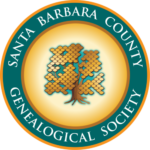Exhibit: Santa Barbara Asian American & Pacific Islander Heritage, 1870s-1970s
Wade Tatsunobu Nomura
- President of Nomura/Yamasaki Landscapes, Inc.
- Humanitarian and Rotarian Extraordinaire
- Former Mayor of Carpinteria
- Author of Creating Destiny
By Mary Jacob and Mary Hancock
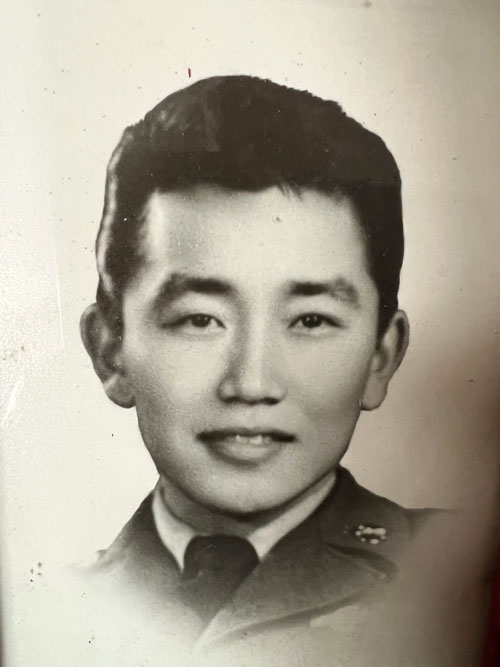
William T. Nomura Service Photo, 1950-51 (Courtesy of Wade Nomura)
Family History
Wade’s paternal grandfather, Hisakichi (William) Nomura, emigrated to Hawai’i from Takata District in Hiroshima Prefecture in early 1907, following his older brother, Masaichi (Charles), who had arrived in San Francisco in 1901. By 1917, Hisakichi had married Tsuchi Morishita and the couple lived in Arcadia, California, near Masaichi, who had married Kofuyu Teruyu. A few years later, Hisakichi and Tsuchi moved to Imperial County, California where he was a self-employed truck farmer and later farm manager. By 1942, the Nomuras and their three children were living on the Mahana Ranch near Calexico where Hisakichi worked for the Azderian Produce Company.
Wade’s maternal great-grandfather, Yoroku Watanabe, arrived in Honolulu in December, 1902, leaving behind his wife Hisa Minzari and 1 ½ year old son, Misao (Jimmy) in Hiroshima Prefecture. Yoroku later settled in San Luis Obispo County, where he worked on the Pecho Ranch. His wife and son joined him there, and by 1920 he was self-employed in the flower seed business. Misao Watanabe married Akiko Moriyama between 1923 and 1925 and had four children. By 1930, Yoruku and son, Misao, were co-owners of a wholesale grocery business in San Luis Obispo.
Detention
In 1942, the Nomura and Watanabe families were detained in the Colorado River Relocation Center near Poston, Arizona in 1942. The Watanabes had been loaded into cattle cars for the journey from San Luis Obispo. According to Wade, they were told “they would be relocated to another place that was safer for them because of anti-vigilante violence [but instead] they were surrounded by barbed wire, and the towers were all armed.” They were often hungry and, to break up the tedium of camp life, Hisakichi, took up woodcarving and made a pair of bookends that Wade still treasures today. And the Watanabe family grew while in detention: Wade’s grandmother, Akiko, gave birth to her fifth child (Tayeko Pauline) in April 1943.
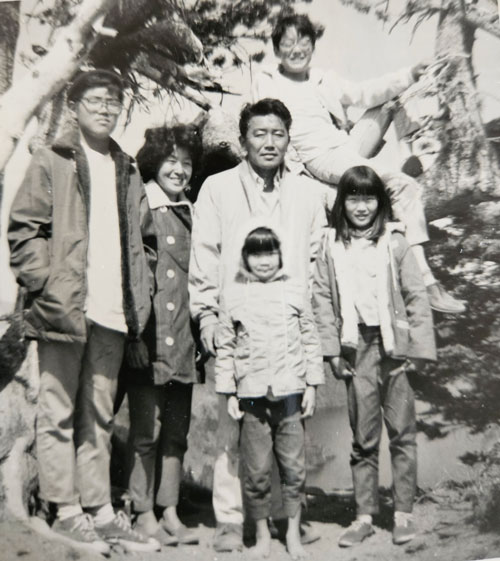
Family Vacation in Mammoth, California, c.1967 Left to right: Wade Nomura, mother Kathleen, father William (Bill, Tats or Lefty), sister Wynne, Brother Weldon, and sister Wendy (Courtesy of Wade Nomura)
In Santa Barbara
Although the Nomura and Watanabe families did not know each other at Poston, both moved to Santa Barbara after their release. Each came with other families, seeking safety by moving as a group. They hoped that Santa Barbara’s Japantown, with its Christian and Buddhist churches, would offer security and help with resettlement. Hisakichi Nomura was soon recruited as a groundskeeper at the estate of Avery Brundage in Montecito, and the family resided there for a few years, later moving to a home on the Mesa. Misao Watanabe settled his family on Canon Perdido Street in Japantown and worked as a gardener.
Wade’s father, William Tatsuro Nomura, graduated from Santa Barbara High School, was drafted into the Army in 1951 and served in the Korean War, driving a munitions truck. After his discharge, he started his own local landscaping business and married Kathleen Satsuko in 1952. Wade was the first of the couple’s children, followed by Weldon, Wendy and Wynne.
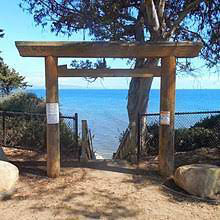
The Torii Gate, Santa Barbara Waterfront. Landscape Design by Wade Nomura. Gate Design by Ted Muneno. (Courtesy of Ted Muneno)
Life and Career
Wade attended schools in Santa Barbara and began his college career at Santa Barbara City College, completing his undergraduate degree at Cal Poly in San Luis Obispo. Wade moved to Carpinteria and started his own landscaping business, which later became Nomura Landscapes, handling landscape projects while his father oversaw the maintenance portion. Later, Wade partnered with John Yamasaki and formed Nomura/Yamasaki Landscapes. Wade’s projects included the landscape designs for the Torii Gate area at Shoreline Park and for the Teahouse Garden at the Santa Barbara Botanic Garden.
Wade has long been active in Carpinteria’s civic life. He served for 18 years on the Architectural Review Board, joined the City Council in 2012 and served recently as Mayor for two consecutive terms making him the longest running mayor of the City. He also volunteers with 35 organizations. He is the Executive Director of the Santa Barbara Junior Golf Tour since 1994; is President of Santa Barbara’s Japanese American Citizens League; and, as a Rotarian, travels the world doing international project evaluation for Rotary and served as the District Governor from 2011-2012 (the first of Japanese descent). Wade’s other interests included BMX bike racing, winning numerous national titles. He also designed his own bike, the Nomura Racing Bike, which led to his induction into the Hall of Fame at the Japanese American Museum along with 41 other athletes.
Reflections on a Life of Work and Service
Wade’s rich life story combines his hard work and artistry as a landscape designer, alongside countless hours of civic, humanitarian and volunteer activities. He recounts his experiences, which are shaped by the intergenerational scars of detention and bigotry, as well as by service, in a recently published autobiography, Creating Destiny. Referring to his family’s and his own experiences of anti-Asian prejudice, on which he has spoken in various forums, “I discuss the topic not in the spirit of resentment and condemnation, but to educate how fear and ignorance can bring out the worst of humanity, and in the hope, history will not repeat itself.”
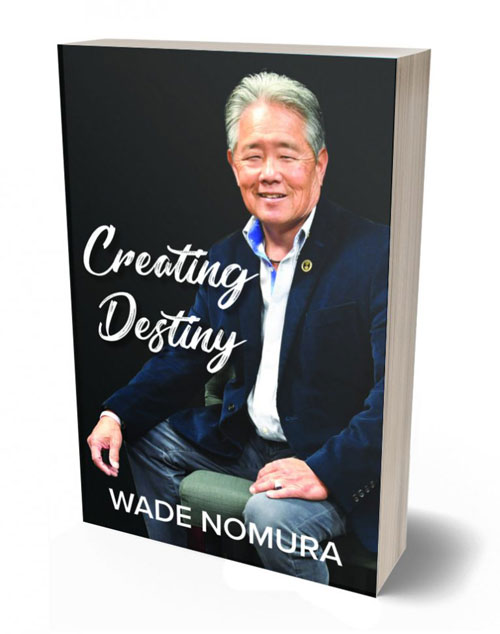
“Creating Destiny,” Wade’s 2021 autobiography (Courtesy of Wade Nomura)
Acknowledgements
Warm thanks to Wade Nomura for sharing his stories and family photographs.
References
“1920 United States Federal Census,” Imperial, California, population schedule, sheet 13B, line 66, Hisakichi Nomura; digital images, Ancestry.com (https://www.ancestry.com: accessed 6 Mar 2023).
“1920 United States Federal Census,” San Luis Obispo, California, population schedule, sheet 24, line 1, Yoroku Watanabe; digital images, Ancestry.com (https://www.ancestry.com: accessed 17 Mar 2023).
“1930 United States Federal Census,” San Luis Obispo, California, population schedule, sheet 16A, line 17, Misao Watanabe; digital images, Ancestry.com (https://www.ancestry.com : accessed 20 Mar 2023).
“California, U.S., Federal Naturalization Records, 1843-1999,” entry for Charles Masaichi Nomura; database and images, Ancestry.com, (https://www.ancestry.com : accessed 6 Mar 2023).
“California, World War I Selective Service System draft registration cards, 1917-1918,” entry for Hisakichi Nomura (image 1471 of 4054); database and images, Family Search (https://www.familysearch.org : accessed 3 Mar 2023).
“Honolulu, Hawaii, U.S., Arriving and Departing Passenger and Crew lists, 1900-1959,” entry for Hisakichi Nomura; database and images, Ancestry.com, (https://www.ancestry.com: accessed 3 Mar 2023).
“Honolulu, Hawaii, U.S., Arriving and Departing Passenger and Crew lists, 1900-1959,” entry for Yoroku Watanabe; database and images, Ancestry.com, (https://www.ancestry.com: accessed 17 Mar 2023).
“Just Being There Represents ‘Nikkei’: Wade Nomura of Carpinteria, CA.” Sept 6, 2019. https://discovernikkei.org/en/journal/2019/9/6/wade-nomura/
